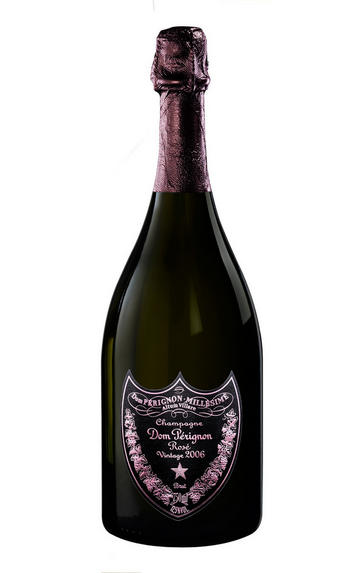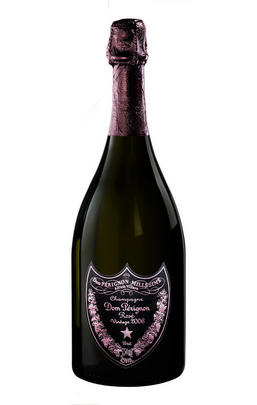
2006 Champagne Dom Pérignon, Rosé, Brut

Critics reviews
The 2006 Dom Pérignon Rosé is every bit as captivating as it was last year, maybe even more so. At times powerful, but in other moments finessed, the 2006 constantly changes in the glass, revealing a different shade of its personality with every taste.
Perhaps most importantly, the 2006 seems to have gained a level of precision and pure sophistication it did not show last year, when it was quite a bit less put together. Back then, the 2006 was a wine of tremendous potential; today that potential is starting to be realized. Quite simply, the 2006 Dom Pérignon Rosé is a magical Champagne. Don’t miss it.
Drink 2020 - 2046
Antonio Galloni, Vinous.com (July 2019)
The 2006 Dom Pérignon Rosé continues to show very well, unfurling in the glass with aromas of bitter orange, dried white flowers, red berries, toast and woodsmoke. On the palate, it's full-bodied, broad and muscular, with all the phenolic structure and depth that one would expect from a rosé that contains more than 20% still red wine, concluding with a sapid and chalky finish. As I wrote earlier this year, this is a vinous, gastronomic rosé that numbers among the decided successes of the 2006 vintage.
Drink 2020 - 2040
William Kelley, Wine Advocate (April 2020)
Pale to mid salmon. A definite orange hue. Broad and rose-scented. Really quite extensive on the palate. Very nicely balanced. Lots of fruit and much softer than the 2008 and 2002 Blanc.
Jancis Robinson MW, JancisRobinson.com (June 2019)
Loads of complexity on offer here, from brioche to dried peaches to strawberries and cream and on to rhubarb fool, pomegranate pastries and bread crumbs. The mousse is wonderfully integrated to the edgy peaches and notes that feather the finest line between oxidation and reduction. Very layered and linear, this is an incredibly long and mind-bending Champagne.
Drink now
James Suckling, JamesSuckling.com (July 2019)
About this WINE

Dom Perignon
Dom Pérignon was the 17th century Benedictine monk who has gone down in history as the person who "invented" Champagne. His name was originally registered by Eugène Mercier. He sold the brand name to Moët & Chandon, which used it as the name for its prestige cuvée, which was first released in 1937.
A rigorous selection process in both the vineyard and winery ensures that only the best grapes go into Dom Pérignon champagne. Chardonnay and Pinot Noir are used in roughly equal proportions without one variety dominating the other.
In its youth, Dom Pérignon shows incredibly smooth, creamy fruit with perfect balance and weight. As it ages, it takes on wonderfully toasty aromas and a finesse equalled by very few of the other Grandes Marques.
Since 2014 Dom Pérignon has no longer been using the term oenothèque for its late-release Champagnes, but the word Plenitude. This style represents Dom Pérignon champagne that is left in contact with its lees and does not evolve in a linear fashion, but ages in a series of stages, producing “windows of opportunity, or plenitudes” when the Champagne can be disgorged and released to bring consumers a different expression of the same vintage.
There are three plenitudes in the life of a given vintage: the first plenitude spans between seven to eight years after the vintage, which is when Dom Pérignon Vintage is released, while the second one arrives between 12 and 15 years – which was previously the first oenothèque release, but from now will be branded as P2. The third window comes after around 30 years, when the Champagne has spent more than 20 years on its lees, which will now be termed as P3.

Rosé Champagne
Rosé wines are produced by leaving the juice of red grapes to macerate on their skins for a brief time to extract pigments (natural colourings). However, Rosé Champagne is notable in that it is produced by the addition of a small percentage of red wine – usually Pinot Noir from the village of Bouzy – during blending.
Recommended Producers : Billecart Salmon (Elizabeth Salmon Rose), Ruinart

Champagne blend
Which grapes are included in the blend, and their proportion, is one of the key factors determining the style of most Champagnes. Three grapes are used - Pinot Noir, Chardonnay and Pinot Meunier.
26% of vineyards in Champagne are planted with Chardonnay and it performs best on the Côtes des Blancs and on the chalk slopes south of Epernay. It is relatively simple to grow, although it buds early and thus is susceptible to spring frosts. It produces lighter, fresher wines than those from Burgundy and gives finesse, fruit and elegance to the final blend. It is the sole grape in Blancs de Blancs, which are some of the richest long-lived Champagnes produced.
Pinot Noir accounts for nearly 40% of the plantings in Champagne and lies at the heart of most blends - it gives Champagne its body, structure, strength and grip. It is planted across Champagne and particularly so in the southern Aube district.
The final component is Pinot Meunier and this constitutes nearly 35% of the plantings. Its durability and resistance to spring frosts make the Marne Valley, a notorious frost pocket, its natural home. It ripens well in poor years and produces a soft, fruity style of wine that is ideal for blending with the more assertive flavours of Pinot Noir. Producers allege that Pinot Meunier lacks ageing potential, but this does not deter Krug from including around 15% of it in their final blends.


Buying options
Add to wishlist
Description
The 2006 Dom Pérignon Rosé is every bit as captivating as it was last year, maybe even more so. At times powerful, but in other moments finessed, the 2006 constantly changes in the glass, revealing a different shade of its personality with every taste.
Perhaps most importantly, the 2006 seems to have gained a level of precision and pure sophistication it did not show last year, when it was quite a bit less put together. Back then, the 2006 was a wine of tremendous potential; today that potential is starting to be realized. Quite simply, the 2006 Dom Pérignon Rosé is a magical Champagne. Don’t miss it.
Drink 2020 - 2046
Antonio Galloni, Vinous.com (July 2019)
wine at a glance
Delivery and quality guarantee